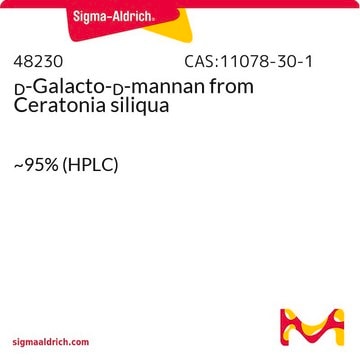G0753
Locust bean gum from Ceratonia siliqua seeds
Sinónimos:
Galactomannan polysaccharide, Gum, locust bean, Manno-galactan (main component)
Iniciar sesiónpara Ver la Fijación de precios por contrato y de la organización
About This Item
Productos recomendados
origen biológico
Ceratonia siliqua seeds
formulario
powder
color
beige
temp. de almacenamiento
room temp
Categorías relacionadas
Aplicación
Locust bean gum (LBG, galactomannan polysaccharide) from Ceratonia siliqua seeds may be used as a substrate to help identify, differentiate and characterize mannanase(s), such as the β-Mannanases (EC 3.2.1.78). LBG may be used in the development of drug delivery devices. LBG may be used to study its properties as a protective agent on both eucalyptus and microcrystalline cellulose destruction of crystallinity by ball milling. LBG may be used to study its properties as a food additive that reduces spoilage caused by Aspergillus flavus. LBG may be used as a starting material for the organic synthesis of hyperbranched N-glycan core structures.
Otras notas
Believed to be a straight chain polymer of mannose with one galactose branch on every fourth mannose and a M.W. of approx. 310 kDa.
To gain a comprehensive understanding of our extensive range of Oligosaccharides for your research, we encourage you to visit our Carbohydrates Category page.
Código de clase de almacenamiento
11 - Combustible Solids
Clase de riesgo para el agua (WGK)
WGK 2
Punto de inflamabilidad (°F)
Not applicable
Punto de inflamabilidad (°C)
Not applicable
Equipo de protección personal
Eyeshields, Gloves, type N95 (US)
Certificados de análisis (COA)
Busque Certificados de análisis (COA) introduciendo el número de lote del producto. Los números de lote se encuentran en la etiqueta del producto después de las palabras «Lot» o «Batch»
¿Ya tiene este producto?
Encuentre la documentación para los productos que ha comprado recientemente en la Biblioteca de documentos.
Los clientes también vieron
T Mohammadi Moghaddam et al.
Journal of the science of food and agriculture, 91(6), 1083-1088 (2011-02-11)
Lallemantia royleana (Balangu) is a mucilaginous endemic plant which is grown in different regions of world. The flow behaviour of Balangu seed extract (BSE) and its mixture with xanthan, guar and locust bean gums at 1:3, 1:1 and 3:1 ratios
Camila P Favaro et al.
Biomolecules, 10(2) (2020-02-09)
Soluble coffee offers the combined benefits of high added value and practicality for its consumers. The hydrolysis of coffee polysaccharides by the biochemical route, using enzymes, is an eco-friendly and sustainable way to improve the quality of this product, while
B M Smith et al.
Journal of food science, 77(6), C684-C689 (2012-06-08)
Carob germ proteins have been shown to have functional properties similar to wheat gluten enabling formulation and production of yeast leavened gluten-free baked goods from a true dough rather than a stiff batter. The purpose of this research was to
Hossein Vaheed et al.
Journal of industrial microbiology & biotechnology, 38(1), 101-111 (2010-09-08)
In this research, ethanol production from carob pod extract (extract) using Zymomonas mobilis with medium optimized by Plackett-Burman (P-B) and response surface methodologies (RSM) was studied. Z. mobilis was recognized as useful for ethanol production from carob pod extract. The
S Sánchez-Segado et al.
Bioresource technology, 104, 324-328 (2011-11-22)
A process for the production of ethanol from carob (Ceratonia siliqua) pods was designed and an economic analysis was carried out for a hypothetical plant. The plant was assumed to perform an aqueous extraction of sugars from the pods followed
Nuestro equipo de científicos tiene experiencia en todas las áreas de investigación: Ciencias de la vida, Ciencia de los materiales, Síntesis química, Cromatografía, Analítica y muchas otras.
Póngase en contacto con el Servicio técnico









